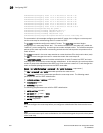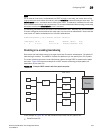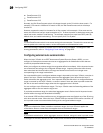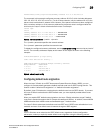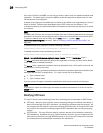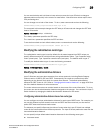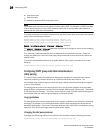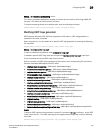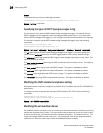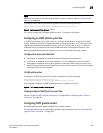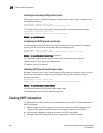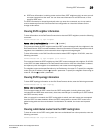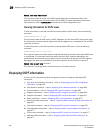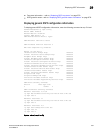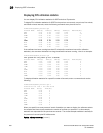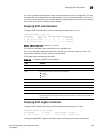
962 PowerConnect B-Series FCX Configuration Guide
53-1002266-01
Configuring OSPF
29
Example
To reinstate the trap, enter the following command.
PowerConnect(config-ospf-router)#trap neighbor-state-change-trap
Syntax: [no] trap <ospf-trap>
Specifying the types of OSPF Syslog messages to log
You can specify which kinds of OSPF-related Syslog messages are logged. By default, the only
OSPF messages that are logged are those indicating possible system errors. If you want other
kinds of OSPF messages to be logged, you can configure the Dell PowerConnect device to log them.
For example, to specify that all OSPF-related Syslog messages be logged, enter the following
commands.
PowerConnect(config)#router ospf
PowerConnect(config-ospf-router)#log all
Syntax: [no] log all | adjacency | bad_packet [checksum] | database | memory | retransmit
The all option causes all OSPF-related Syslog messages to be logged. If you later disable this
option with the no log all command, the OSPF logging options return to their default settings.
The adjacency option logs essential OSPF neighbor state changes, especially on error cases. This
option is disabled by default.
The bad_packet checksum option logs all OSPF packets that have checksum errors. This option is
enabled by default.
The bad_packet option logs all other bad OSPF packets. This option is disabled by default.
The database option logs OSPF LSA-related information. This option is disabled by default.
The memory option logs abnormal OSPF memory usage. This option is enabled by default.
The retransmit option logs OSPF retransmission activities. This option is disabled by default.
Modifying the OSPF standard compliance setting
Dell PowerConnect routers are configured, by default, to be compliant with the RFC 1583 OSPF V2
specification.
To configure a router to operate with the latest OSPF standard, RFC 2178, enter the following
commands.
PowerConnect(config)#router ospf
PowerConnect(config-ospf-router)#no rfc1583-compatibility
Syntax: [no] rfc1583-compatibility
Modifying the exit overflow interval
If a database overflow condition occurs on a router, the router eliminates the condition by removing
entries that originated on the router. The exit overflow interval allows you to set how often a Layer
3 Switch checks to see if the overflow condition has been eliminated. The default value is 0. The
range is 0 through 86400 seconds (24 hours). If the configured value of the database overflow
interval is zero, then the router never leaves the database overflow condition.



